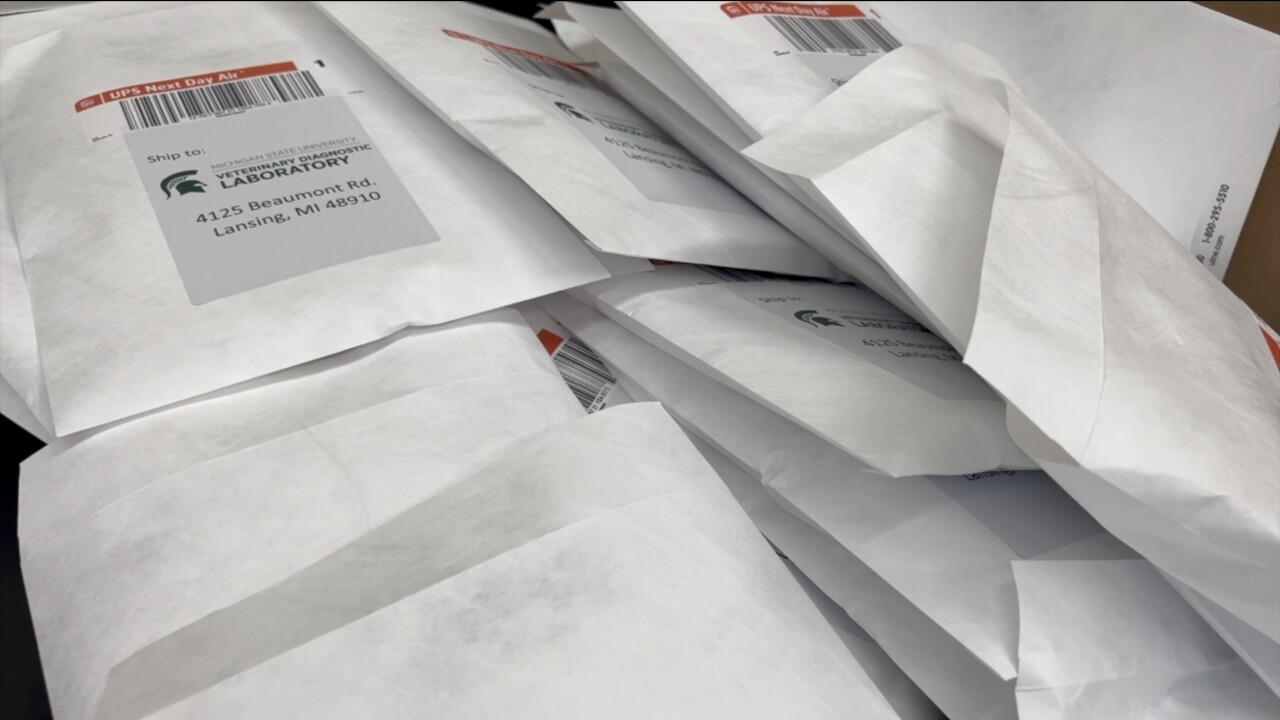EAST LANSING, Mich — It’s almost invisible.
Nearly indestructible.
And always fatal.
Chronic Wasting Disease or CWD is a contagious neurological disease caused by a misfolded protein— called a prion— that infects our cervids, which include deer, elk, and moose, creating holes in the brain and eventual death.
"This disease will just slowly start to chip away at the deer population, and that's really the big challenge," Dr. Sonja Christensen with the Fisheries and Wildlife Department of Michigan State University told me from their building in East Lansing.

First documented in Colorado in the late 1970s, cases have crept across the country since – with the first confirmed case in free-ranging white-tailed deer found here in the state in 2015.
Since then, about 255 deer have tested positive for CWD in Michigan, according to the Michigan Department of Natural Resources.
Those numbers might not look too alarming at first in the grand scheme of wildlife disease, but Dr. Christensen says we need to get ahead of this now.
"It might not affect us today directly, but it's going to affect the herds in years to come," Dr. Christensen said. "The hunting opportunities for our grandkids, for example, because it is infectious and we can't get rid of it once it's introduced.
A problem already on full display out West.
RELATED: 'Zombie deer disease' has now spread to 33 states in the US
"In places like Wyoming and Colorado, where this disease has been on the landscape for a long time, there are places where mule deer populations have declined by 10%." Dr. Christensen added.
This isn't the only potential issue. With more infections on the landscape, there could be an increased chance of human exposure - which isn’t great - because similar diseases like Mad Cow, have made the jump to humans before.
But the news on this so far, is so good.
“I think it's important to point out that this hasn't been directly related to, you know, human-caused disease, or human disease," Dr. Christensen told me. "This hasn't been directly related to human disease from chronic wasting disease, so it's really personal risk mitigation that people have to be thinking about... but I tend to get my deer tested .”
That’s even more of a reason to take this disease seriously now.
"It is a numbers game, you know, it's a numbers game from a few different perspectives," added Dr. Christensen. "It's a numbers game in terms of how many infectious deer are on the landscape. And our whole goal is to remove more of those animals on the landscape than are being infected in a given year, right? So if we can reduce the number of total infected animals on the landscape, we can try to control it. And again, getting it early is the best chance. Because once it's going, it's just, it's a hard one to contain, and then the numbers game of, you know, the more you expose yourself to infectious meat. You know, nobody wants to be ground zero. Nobody wants to be case number one.”

So what can we do?
Melinda Cosgrove with the Michigan DNR says hunters play a big part in stopping the spread.
"If you're hunting in an area that's known to be infected, don't move it outside of that area," said Cosgrove. "We recommend deboning the meat first, disposing of any brain or spinal column through a landfill prior to leaving the area, obviously not moving them across state lines."
In addition to that, both Melinda and Sonja recommend getting your deer tested either at DNR staffed check-station or by sending in the lymph nodes from your deer for testing with a kit.

Both options are available in certain counties across the state where the DNR is doing a rotating surveillance approach. You can find the list of target areas here.
And if it comes back positive for CWD – don’t eat it.
AGAIN, there is no requirement to do this, and no proven human disease has come from eating CWD-infected meat, but the people who study Chronic Wasting Disease still think it’s better to be safe than sorry.

"I can't, I can't convince you to... to do something that you don't believe in. I can give you, I can present you with the information that we have," said Cosgrove. "I have talked to plenty of hunters who actually did turn in their deer for testing, and it was a big, healthy buck, and when I talked to him about a positive test result, they were completely surprised, and that was always the first thing they would hear. But he was really healthy and looked really good. And I think maybe that sometimes changes people's mind that they're not seeing it on the landscape.”
And action now could stop problems later.
“Let's try to buy ourselves some of that time by removing those sick animals off the landscape or a better understanding of what the disease is doing so we can mitigate that spread and try to control it as much as we can do,” added Dr. Christensen.
READ ALSO: Chronic Wasting Disease found in Newaygo County deer
Follow FOX 17: Facebook - X (formerly Twitter) - Instagram - YouTube




